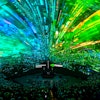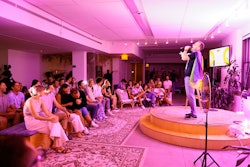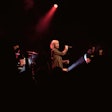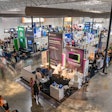
In 2013, 86.2% of businesses with at least 100 employees used social media as a tool for marketing. According to Statista, that figure rose to a whopping 92.1% by the end of 2022—and that doesn’t even account for the small businesses with teams under 100 or freelancers that function as a one-(wo)man show. All the while, each of the big players in social media became socially segmented. When thinking about business, LinkedIn probably comes to mind; meanwhile, Facebook fed into family life, Instagram became a sort of e-commerce platform, and Pinterest was always for inspiration.
However, beyond what each social media site is best for, how are event professionals taking advantage of these platforms? And should you really be on TikTok? To help you make your next social move, BizBash asked three industry veterans about their scrolling habits…
(Naturally, we crowdsourced these quotes via LinkedIn; follow us and join our group, Event Pros Gather, to contribute to future stories!)
Amanda Rodriguez, the social media and PR specialist at Minnesota-based, full-service AV company The 180 Group, said she and her team reevaluated the brand’s social media messaging in 2022 and “made the decision to bring social media in-house.” She noted that the move makes for a “commitment to providing our customers with human-centered content and up-to-date information about our products and services.” Amanda Rodriguez, the social media and PR specialist for full-service AV company The 180 Group.Photo: Courtesy of Amanda Rodriguez
Amanda Rodriguez, the social media and PR specialist for full-service AV company The 180 Group.Photo: Courtesy of Amanda Rodriguez
With an in-house social media team equipped to tell “engaging stories” and “encourage more meaningful conversations between staff and event professionals,” Rodriguez said they’re looking to “short-form video content” as a means of getting the ball rolling. “TikTok boomed in engagement, and Instagram announced that it’s no longer just a photo-sharing app," she added.
In fact, the announcement stirred up media in late 2023 when Adam Mosseri, the head of Instagram, fittingly took to the app via video captioned: “We’re no longer just a square photo-sharing app.”
He went on to say: “There’s some really serious competition right now. TikTok is huge, YouTube is even bigger”—and the sentiment rings true a year and a half later.
How Rodriguez makes sure The 180 Group is staying relevant? “We experimented with trending sounds and visuals on TikTok and Instagram Reels to see how we can translate our services into short-form video content that was valuable and entertaining.”
Still not sure how to take to video? Well, Rodriguez pointed to Instagram Stories and Reels as a great “space to build community and let our personalities shine through our portfolio aesthetic." And TikTok serves as more of “a creative refuge where we can completely be ourselves to a mass audience without ‘corporate culture’ restraints.”
Rodriguez noted that she puts Pinterest to use for “building mood boards or concept imagery for marketing campaigns [that] really helps narrow down specific elements [of] a creative direction." And she pointed to TikTok for information on trends (she follows @thealgorythm and @oldloserinbrooklyn), “quick lessons on iPhone cinematography, [and] Canva hacks.”
 Erica Kolin, the CEO and director of events at event and production firm EK Events.Photo: Courtesy of Erica Kolin
Erica Kolin, the CEO and director of events at event and production firm EK Events.Photo: Courtesy of Erica Kolin
Erica Kolin, the CEO and director of events at Chicago event and production firm EK Events, said that “in 2022, my clients spent much more money on a larger array of event tech to capture live videos and photos from events.” From there, content is repurposed onto her most-used platforms: Twitter, TikTok, and Instagram.
The strategy? “To create FOMO [fear of missing out].” Kolin also noted that “giving customers and attendees a behind-the-scenes look at events” will be an industry trend as we move into 2023.
Meanwhile, Kevin Hubschmann, the New York-based founder and host of custom comedy and team-building experiential company Laugh.Events said he focuses on three main social media platforms: TikTok (unsurprisingly), LinkedIn, and Instagram. However, they all serve a different purpose.
“TikTok is focused on our NSFW [not safe for work] shows,” he said, while “LinkedIn is focused on our corporate offerings, and Instagram attempts to be a blend of the two.” Hubschmann noted the importance of being “incredibly conscious of why people go on each of these platforms [to be able to] serve up content that makes the most sense.”
But “TikTok is the platform that we’ve seen the most success on,” he said, attributing it to the app’s algorithm, which “relates to impressions and follower growth.” And to support his previous point about meeting the audience on whichever platform they’re on, he cited Laugh.Events’ 81,525% increase in followers on TikTok–versus 18% on Instagram. “The crazy thing is that the content is pretty much the same.”
And like Kolin, Hubschmann also sees the value in repurposing pre-recorded content from events anywhere he can. “We try and film as often as possible and create clips from our live shows," he explained.
 Kevin Hubschmann, the founder and host of custom comedy and team-building experiential company Laugh.Events.Photo: Courtesy of Kevin Hubschmann
Kevin Hubschmann, the founder and host of custom comedy and team-building experiential company Laugh.Events.Photo: Courtesy of Kevin Hubschmann
As for Pinterest, Hubschmann said he and his team are “constantly looking at Pinterest to see how others have nailed concepts, and then [we] put our own spin on it.” He pointed to Laugh.Events’ DEI Calendar, “where we highlight comics during different culture-appreciation months,” as an example of something that was inspired by the platform.
He also advised event profs to lean into trends, which Laugh.Events did with the Little Miss trend with a post that read “Little Miss laughs at all her own jokes."
Despite seeing success in the trendy post, Hubschmann noted that he finds Instagram the most difficult platform to find success on, as “the algorithm seems to be changing constantly.” Thus, in 2023, he plans to “continue to focus on creating content that can be easily published across all of our platforms” while also leaning on “brands, influencers, and comics that have large followings [in order to] grow our impressions and followers through those collaborations.”



















